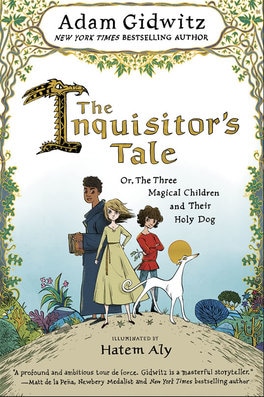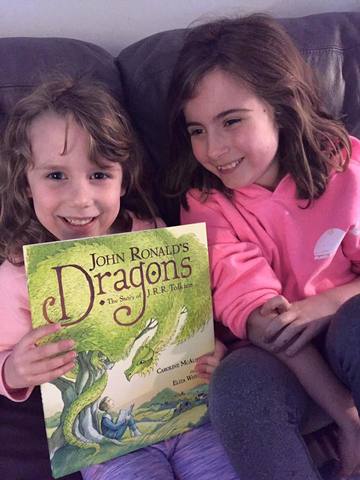|
First I want to thank Eliza Wheeler's amazing husband who had the computer skills to put together this trailer for John Ronald's Dragons. The way he makes the figures in the background move is called parallaxing. As someone who struggles daily with simple classroom management software (moodle an canvas ugh!) I am forever impressed by and grateful to those who can combine technical and creative skills with grace. Second, I want to point out that last Saturday, March 25th, was Tolkien reading day. Our Carolinas SCBWI leader, Teresa Fannin, sent me a beautiful article explaining the significance of the date. Apparently dates in Tolkien's books are just as carefully chosen as the names of his characters. I celebrated Tolkien reading day by reading John Ronald's Dragons at Scuppernong's Bookstore, a warm, quirky community bookstore in downtown Greensboro. Third, I want to review a book I read over my spring break, Adam Gidwitz's middle grade novel The InQuisitor's Tale.  The Inquisitor's Tale by Adam Gidwitz is amazing! This is the book I wish I had written. It is the book I wish I could go back and read to my kids using my special time turner travel kit. It is the book I wish the college kids I teach had grown up reading because it would make them wise, thoughtful, and literate about that strange country, the past, more specifically the past of the middle ages. Adam Gidwitz's three main characters are two boys and a girl as in the Harry Potter formula, but he builds on this formula by adding a dog and by making one child black, one child Jewish, and one child a peasant, thus taking on the topics of class, race, and religion. Gidwitz builds on actual Saints' legends, which are great and gory stories, and mixes them up with the modern superhero trope. And what are saints but superheros with magical powers? The mash up makes the past new and the present old. Again following a classic kid lit formula the three children are relieved of parental comfort and authority early in the novel. In picaresque fashion they wander the French countryside and have adventures with silly knights, a farting dragon, a close minded queen, and a fat angel. But along with the fart jokes, Gidwitdz takes on deep questions: the origins of mistrust and conflict between Christians and Jews, the construction of racial difference, the banning and burning of books and the biggest question--if God is good, why does he allow terrible suffering. Also, the book is beautiful to behold. The illustrator, Hatem Aly, has decorated the margins with charming illuminations and doodles that are like the text, historically informed but also modern. I now want to read the book a second time (I had to read it really fast the first time to find out what happens), and dawdle and peruse the pictures and their relationship to the text. I also love that this is a book about mutual understanding between different religions and the author is Jewish and the illustrator is Muslim. What could be more perfect? And for adults who read the book to their children (and why wouldn't you?) you must read the elegant author's note which explains how much of the story is based on actual medieval legends and lore.
17 Comments
John Ronald's Dragons has launched, and it is thrilling to hear from all of the people who are reading and enjoying it. As the book has come out so have the reviews. Publishers Weekly really understood the purpose of the book, to introduce younger readers to Tolkien before they encounter him in middle or high school. Here is their review:
The dragons of imagination are always there, but sometimes it takes time for them to breathe fire—that’s what McAlister (Holy Molé!) suggests in this thoughtful look at the creative development of John Ronald, aka J.R.R. Tolkien. Reflecting Ronald’s lifelong preoccupation with dragons, Wheeler’s (This Is Our Baby, Born Today) illustrations blend hints of the fantastical and the mundane—chimney plumes and steam from a young Ronald’s oatmeal mimic the smoke curling from an imagined dragon’s nostrils. McAlister moves briskly through Ronald’s life, touching on the influences of his faith, military service, and education before he hit upon the invention of a hobbit, one who would lead him all the way to “a dragon named Smaug.” It’s an ideal lead-in to family readings of The Hobbit. Ages 4–8. Author’s agent: Jennifer Mattson, Andrea Brown Literary. Illustrator’s agent: Jennifer Rofé, Andrea Brown Literary. (Mar.) The Horn Book also gave the book a good review and points out how I introduce Tolkien's themes and show their origins in his childhood. This picture-book biography of J. R. R. Tolkien shows the roots of many themes later found in The Hobbit and the Lord of the Rings trilogy. McAlister introduces John as a boy who loves horses, trees, words, and especially dragons. We see young John encountering dragons in Andrew Lang’s famous colored Fairy Books, making up a language with his cousin, and eventually fighting in WWI, teaching, and writing stories. Despite Tolkien’s sometimes-difficult young life (after his mother died, he and his brother lived with an aunt who “didn’t like boys”), the prevailing tone is one of warmth and security. Wheeler’s illustrations, in what look like line and watercolor, are deftly executed in light colors with carefully placed darker shades that ground her compositions. Swirling shapes and trees silhouetted against pearly skies are reminiscent of Rackham, an appropriate reference given the subject and time period. The book finishes with Tolkien’s conception of The Hobbit; the final illustration shows the author “discovering” the great dragon Smaug in his mountain cave. An author’s note fills in the gaps in Tolkien’s story, and an illustrator’s note points out pictorial references to actual books, locations, and people not mentioned in the text. “A Catalog of Tolkien’s Dragons,” “Quotes from Tolkien’s Scholarly Writing on Dragons,” and a bibliography are appended. lolly robinson The one not so nice review came from School Library Journal, a big disappointment since I want to sell to schools and libraries: Gr 1-4–McAlister’s picture book introduction to the life of J.R.R. Tolkien (whom she calls John Ronald) is written in simple, descriptive language—a fragment to six short sentences per page or spread. (“John Ronald was a boy who loved horses. And trees. And strange sounding words.”) Critical to John Ronald’s life were the “stillness, beauty, and peace” of the Catholic Church; his love of English (coming up with new languages and using them to write stories); his lifelong school friends who shared his love of literature; and his dreams of dragons and other fantastical creatures that inhabited the books read to him and his brother by their mother, who died when John Ronald was 12. After marrying, then fighting in the trenches during World War I, Tolkien taught at Oxford University, where he gave lectures, went to meetings, tutored students, and “graded many, many, exams.” The world of the Hobbit and his adventures, created for Tolkien’s own children, became a book in 1937. Wheeler’s pencil-detailed paintings in subdued greens and yellows effectively portray Tolkien’s quiet life and his ability to imagine magical creatures and places (Misty Mountains, Mirkwood Forest) in the countryside around his home. The appended illustrator’s note points out elements in the pictures not mentioned in the text. An author’s note offers more sophisticated facts; a bibliography lists Tolkien biographies for adults. VERDICT This beautifully illustrated introduction to Tolkien’s life for younger readers fails to provide sufficient information to satisfy those old enough to appreciate the lengthy, in-depth storytelling style of his novels.–Susan Scheps, formerly at Shaker Public Library, OH This last reviewer wanted a different kind of book, a middle grade or YA biography because Tolkien's books are read by middle grade and YA readers. But my conception and Eliza's as well was to write a book about how a writer's imagination begins to take shape in childhood and to write this for children. What I have learned as a teacher from this experience is to be a more thoughtful grader, to think not about the ideal paper I have in my head, but to think about the student's objectives, the student's purpose in creating a piece of writing and whether the student has achieved that purpose. The next set of papers I get, I will ask students to articulate for me what they have tried to realize with this piece of writing. (Just doing that is an important step as a writer.) Then I will try to grade them based on whether their creation does what they meant it to do. . |
Caroline McAlisterCaroline is an avid reader, children's writer, and teacher. She lives in North Carolina with her husband and dog. Check out her bio for more! Archives
February 2024
Categories
All
|

 RSS Feed
RSS Feed